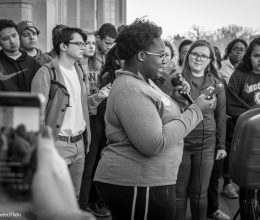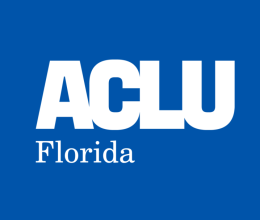
The “so-called” School Safety bill is now on its way to the Governor. Students, teachers and parents across the state have pleaded with the Legislature not to arm teachers. The call went unheeded. While the prospect of guns in classrooms is alarming, the bill also has other harmful policies. Instead of focusing on increasing school-based mental health services and programming focused on building healthy school climates where students feel safe to learn, the bill increases school policing and erodes student privacy rights.
The Good: Refined Mental Health Services
In line with the ACLU, advocates and youth justice organizations’ call for increased investment in school-based mental health providers to bolster safe school climates, the Florida Legislature required school districts to develop a plan to spend state school mental health dollars on:
- Employing school-based mental health providers (school counselors, psychologists, social workers, etc.) in numbers that better align with nationally recommended ratios. No Florida school district currently meets these recommendations and many students attend schools with police or armed staff, but no counselor.
- Increasing the time school-based mental health providers spend on direct services to students. Many schools rely on school counselors, social workers and even psychologists to do administrative tasks, test proctoring and supervision, such as bus or lunch duty.
- Ensuring at-risk students receive assessments, screenings and services within 15 days of referral and support from community providers within 30 days of referral.
- Employing strategies and programs that reduce the risk of students developing social, emotional and behavioral health problems.
- Improving early identification and treatment of social, emotional and behavioral health problems and improving assistance to students dealing with trauma or violence.
Unfortunately, the budget illustrates where the Legislature's priorities truely lie: the Mental Health Assistance Allocation to local school districts was increased by 8% to a total of $75 million, or $26.47 per student. To contrast, the Safe Schools Allocation, which funds school police and school security provisions, was increased 11% to $180 million, or $63.53 per student, not including the $500,000 available to train and arm school guardians or the $50 million available for building security.
ADVOCATE: Get involved with your school board to monitor how this is being implemented locally. You can find your district’s mental health plan here.
The Bad: Student Privacy on the Chopping Block
This year’s legislation furthers the trend of infringing on privacy rights in the name of security. Last year, Florida established the first statewide centralized student data repository - one database with all of the information about each youth held by the state and local departments of child welfare, education, juvenile justice and law enforcement. Many of these records are supposed to be confidential. Law enforcement generally needs warrants to gain access to such records, but policymakers, educators and law enforcement are pushing to maximize access.
- This year’s legislation creates a taskforce to study adding a Threat Assessment Database to the centralized student database. Threat Assessments are best used to distinguish actual threats from normal adolescent venting, sarcasm and jokes. Given the wide net cast to ensure threats do not go undetected and that youth of color and youth with disabilities are more likely to be seen as threats, it is inappropriate and harmful to use threat assessments to label or track students. This is further evidenced by the fact that the Marjory Stoneman Douglas Commission recommended that every student with an individualized education plan for severe behavioral issues undergo a threat assessment. We cannot repeat the consequences of indiscriminately labeling kids that have plagued school discipline and juvenile justice. Such labels strip young people of any benefit of the doubt and forever alter their identity.
- Currently, there are no legal restrictions on the length of time student data can be maintained in the system.
- Information systems are notorious targets for hackers and a system such as this will provide a lucrative trove of information. Connecting different systems in order to share data creates more access points for hackers, leaving student’s confidential and private information vulnerable to the public.
- Systems of this magnitude, that require integration of data collected by different entities for different purposes, are enormously expensive.
- Although we were successful in pushing against a law requiring a statewide social media surveillance tool, the DOE is poised to create one. It will be up to local school districts whether and how they use it.
ADVOCATE:
- Contact the Commissioner of Education and the Office of Safe Schools to push for restrictions on the length of time data will be kept and to whom access will be given.
- Get involved with your local School Board to ensure they are prioritizing student privacy.
The Ugly: Expanded Zero Tolerance Policies
Despite the evidence that discipline reforms had nothing to do with the Parkland tragedy and were combatting the school-to-prison pipeline, the Florida Legislature expanded the zero-tolerance law, which requires certain offenses at schools be reported to law enforcement.
- Under the previous law, which was clarified after students were arrested for gun-shaped pop tarts and science experiments, it was clear that normal youth behavior like fights, petty theft and petty vandalism did not have to be referred to law enforcement. The Legislature removed that clarity, expanding the statute to cover petty acts of misconduct.
ADVOCATE: Get involved with your school board to ensure local zero tolerance policies are not expanded to the detriment of school safety. Request the district’s memorandum(s) of understanding with local law enforcement, discipline code and matrix.
“Safe School Officers”
The law continues to require that every school have a “safe school officer,” but the legislation, beyond allowing that person to be a teacher, allows the school to hire or contract a security guard.
From the evidence on guns in homes and the experience of the last year, we can expect that guns around children will lead to guns being used on and around children. In Florida alone, we have seen a School Guardian in line to be a School Resource Officer murder his family and die by suicide outside a school and a School Resource Officer accidentally discharge his gun in a middle school lunchroom. Stories continue to roll in across the country highlighting the risk guns in schools present in even the most trained, well-intentioned hands. We also know from research on police-involved shootings and implicit bias in schools that the risk for Black students will be even greater.
Despite often being characterized as different from general police, the law requires no special training for police officers to serve as school resource officers. From decades of research and evidence, we know police stationed in schools will arrest students. We know these students will be disproportionately Black and Brown, have disabilities and/or be LGB and gender nonconforming. We also know that police will use force on our kids that we’d never accept from teachers or even parents, including tasers and pepper spray.
Therefore, until this law is changed, schools’ best option for compliance that puts student safety and wellbeing first seems to be employing guards to secure the perimeter of campus.
Visit our School Safety Advocacy Toolkit for more resources to advocate for safe schools in your community.







